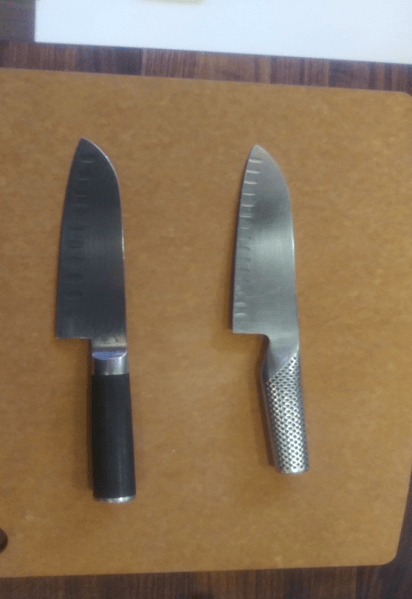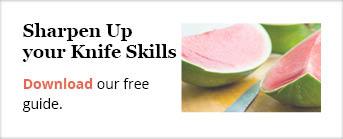
When I first started culinary school, one of the first things I did was pick up my school-assigned “Chef’s Kit.” I could barely contain my glee as I took my bounty home. I started familiarizing myself with every tool, piece by piece. From pastry tips to various whisks and spoons, they were all fun to look at, but the real prize was found at the bottom of the bag. Behold, my first real knife! The knife that I would come to use as my Excalibur was an 8-inch Henkels chef's knife. The way it felt in my hand seemed natural. It became the star of my chef’s kit and helped me chop, slice and dice my way through school.
Years later, I ended up working in my first fine-dining restaurant as the newest member of the Garde Manger department. One day, one of the sous chefs was talking to me about my knife, which I admit was of low quality (the Henkle was long lost at this point in my culinary journey). He said “Sometimes to do the right job you need the right tool,” and he introduced me to the world of Japanese knives. He asked me what I wanted in a knife, and I blurted out “speed and size” and by size, I meant small. At that moment, he handed me what would be the knife I have used for almost my entire cooking career thereafter: the Santoku knife.

So, what exactly is a Santoku knife, and what makes it so special?
During the early 1950’s, the Japanese home cook needed an alternative to traditional cleavers for everyday use and found that in the form of a lightweight knife that could chop, slice and dice - the 3 Virtues of Cutting, which translates to Santoku. Now, I'm not saying that Santoku knives are better than all other chefs’ knives because it's all about personal preference.
Let’s look at the main features of the Santoku knife:
- Lightweight
- Thin blade for finer cuts
- Small size (5-8 inches)
- Granton edge - that helps food to not stick to the knife
- Sharper angle then traditional knives
Uses:
- Chopping and dicing
- Mincing herbs
- Slicing meats
- Fine cutting
- Scooping food
What about that shape? Since Santoku knives took the place of cleavers they tend to have a boxier shape and tend to have a straight cutting edge with a less pronounced point, this gives you a more refined cut.
Now that we know what the Santoku knife offers, how do we choose the right one?
First off, let's look at the quality of metals available. Traditionally Santokus tend to be made out of stainless steel, but in today's market you can find them made from ceramic and high carbon steel as well. Since I started teaching at The Chopping Block, I have had access to some fine knives but tend to keep going back to our Global Santoku knives.
The Global Santoku knife is constructed of a CROMOVA 18 high carbon steel and has a blade edge that is ground on both sides to give you a straight sharp edge. It is also very light but has just enough weight in the handle to keep it from being classified as ultra lightweight.
Finally, let's look at pricing.
The market has become saturated in recent years with many different brands from Mac’s to Victorinox, but the Global brand knives tend to be very well made and reasonably priced at under $150 dollars. Remember that sometimes you get what you pay for, so it could be necessary to splurge just a bit. If you do, your knife may last as long as you do!
Now that you have it, how do you care for your knife?
It is always recommended to handwash your knives and hand dry them. Stay away from metal scrubbies and anything that's too abrasive. Machine washing your knife is not recommended. Knife guards are also highly recommended to keep your knife properly protected.
Keep that knife sharp!
Santoku knives have a single bevel and are made from a harder steel. It is easier to create a finer angle on the one side making for a sharper knife with a whetstone. Whetstones can be found at almost any culinary store or online cooking retailer.
Basic whetstone steps:
- Submerge and soak whetstone in water.
- Using the coarse side first, tilt the knife at the correct angle.
- Run the knife up and down the stone in a smooth motion.
- Ensure you cover the whole blade from edge to start of handle.
- Repeat process on other side if knife is double-beveled.
- Flip stone to the finer side and repeat again.
- Thoroughly wash and dry knife by hand.
Now you're on your way to selecting the Santoku knife that is right for you. If you need somewhere to hone your knife skills please check out our popular Knife Skills classes on our calendar. Here are some upcoming sessions to choose from:
- Monday, March 9 7pm Lincoln Square
- Saturday, March 14 12pm Lincoln Square
- Sunday, March 15 11am Merchandise Mart
- Tuesday, March 17 6pm Merchandise Mart
If you want to get started on improving your knife skills at home before you purchase your Santoku knife, download our free guide Knife Skills 101.

